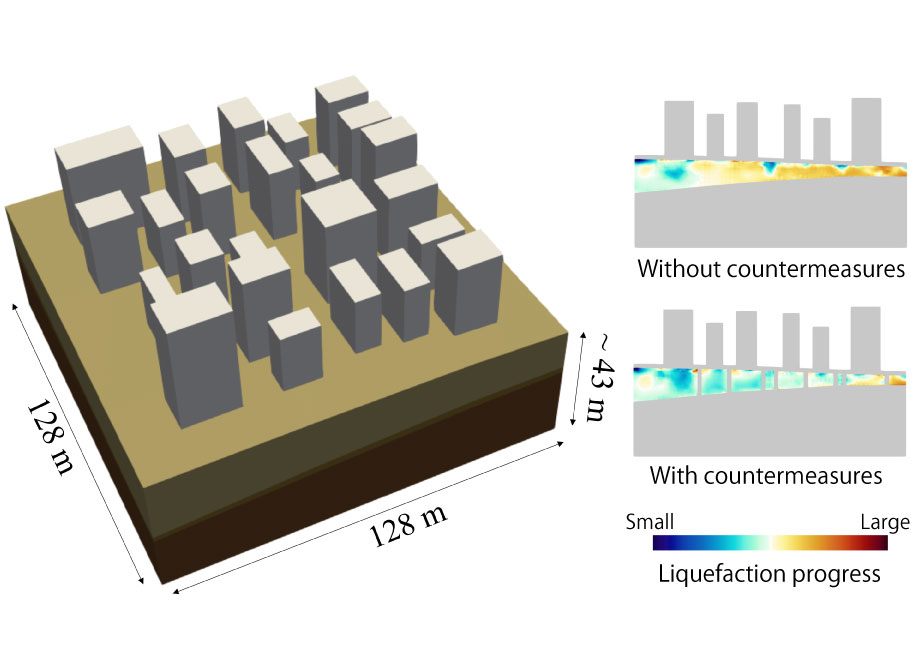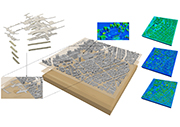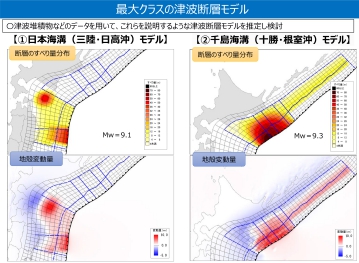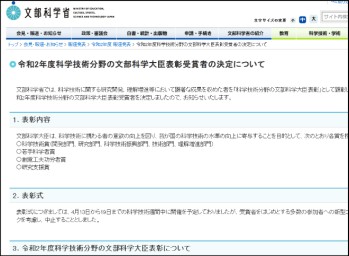|
|
|
Feb. 2021
At The 3rd R-CCS International Symposium held on February 15-16, 2021, Project Leader Dr. Takane Hori gave an invited talk titled "Large-scale numerical simulation of Large-scale numerical simulation of earthquake generation, wave propagation and soil amplification" and introduced our research project.
Title : "Large-scale numerical simulation of earthquake generation, wave propagation and soil amplification"
Abstract : In one of the programs for Promoting Researches on the Supercomputer Fugaku, entitled "Large-scale numerical simulation of earthquake generation, wave propagation and soil amplification", we have two large research topics. One is application of the developed simulation codes based on large-scale finite element modeling to earthquake and tsunami damage prediction methods aiming for formulating damage estimates by the Japanese government. For this purpose, we make necessary improvements to the developed simulation codes in cooperation with national agencies. We also develop a computing platform on which construction and civil engineering companies can use the same framework of earthquake and tsunami damage prediction as used in damage estimates by the government. The other topic is development of computational methods for large-scale computation aiming for earthquake damage prediction by Prof. Ichimura’s group at Earthquake Research Institute, the University of Tokyo. They develop and improve the computational methods for large-scale computation aiming for earthquake damage prediction. The state-of-the-art techniques of computational and computer science are applied to achieve high-performance computation using Fugak;.
Details...
|
| |
Feb. 2021
In the Journal of Computational Science (Volume 49, February 2021), Prof. Ichimura's team has published some of the research results related to the project "Development of large-scale applications for disaster damage prediction related to earthquakes", which aims to enable us to exploit the performance of the supercomputer Fugaku by using the most advanced technologies in computational science and computer science.
This research project aims to create more advanced disaster damage prediction by improving the computational methods developed for "K computer", the predecessor of Fugaku, to optimize the performance characteristics of Fugaku. This paper presents one of such developed methods. By using this method on Fugaku, which is capable of exploiting the performance of Fugaku, a 59-fold speed-up was achieved compared to using the conventional method on the K computer. This research corresponds to the application to the disaster prediction problem related to earthquakes, in cooperation with the co-design in the development of Fugaku, which has been carried out jointly with RIKEN and Fujitsu as part of the social and scientific issues to be focused on in the post-K project (Priority Issue 3). In this project, we aim to create more advanced disaster damage prediction by utilizing the results of this project. The developed method can be applied to a wide range of other problems in the field of seismology, and is also expected to be useful and effective in other fields that use the finite element method.
Journal of Computational Science : High-fidelity nonlinear low-order unstructured implicit finite-element seismic simulation of important structures by accelerated element-by-element method. Kohei Fujita, Kentaro Koyama, Kazuo Minami, Hikaru Inoue, Seiya Nishizawa, Miwako Tsuji, Tatsuo Nishiki, Tsuyoshi Ichimura, Muneo Hori and Lalith Maddegedara. Journal of Computational Science, 2021
|
 |
Jan. 2021
Some of the research results of Prof. Ichimura's team were published on "Regional Seismic Ground-Motion Simulation and Observation with Engineering Applications" special issue of "Earthquake Engineering and Structural Dynamics (EESD)(Volume 50, Issue 1, January 2021)". It can be said that their research and development from the computational science aspect has been recognized in the field of earthquake engineering.
Numerical analysis methods that are being developed using large-scale computers such as the supercomputer Fugaku need to be improved so that they can be used more widely in the real world. As one such improvement, this paper presents the development of a method for accelerating large-scale seismic response analysis using GPUs.
The newly developed method is designed to perform more calculations with continuous memory access, which GPUs are good at. When this method was used to analyze soil liquefaction during earthquakes, it was able to perform calculations 10 times faster than the conventional method using CPUs. In addition, by using OpenACC, it made possible to reduce the development cost incurred by rewriting the program.
This method is expected to encourage the practical use of the disaster prevention-related programs being developed on the supercomputer Fugaku in the real world.
Wiley Online Library : Ryota Kusakabe, Kohei Fujita, Tsuyoshi Ichimura, Takuma Yamaguchi, Muneo Hori, Lalith Wijerathne, Development of regional simulation of seismic ground-motion and induced liquefaction enhanced by GPU computing, Earthquake Engineering & Structural Dynamics.
|
 |
Nov. 2020
Prof. Tsuyoshi Ichimura and his research team will give a talk in the research poster session at SC20 (“The International Conference for High Performance Computing, Networking, Storage and Analysis” held on November 17-19, 2020). In their study "Development of large-scale applications for predicting disaster damage related to earthquakes", they achieved a great performance in the Supercomputer Fugaku by using cutting-edge technologies in computational and computer science.
In large-scale earthquake simulations, random memory access, which makes it difficult to perform efficient calculation with a large amount of data, is known to degrade the performance of the simulations. Prof. Ichimura’s team has proposed a remedy for this degradation of performance by developing a method that performs large-scale simulations at high speed by introducing data-driven learning, as represented by Artificial Intelligence, which is associated with calculation based on sequential memory access.
This newly developed method delivers 15-times faster calculation compared to a conventional and widely-used method. Furthermore, while using many CPU cores generally degrades the performance of the calculation, the proposed method maintains its performance even with 1.2 million CPU cores.
SC20 Research Posters Display : ”Fast Scalable Implicit Solver with Convergence of Physics-Based Simulation and Data-Driven Learning: Toward High-Fidelity Simulation with Digital Twin City”., Tsuyoshi Ichimura, Kohei Fujita, Kentaro Koyama, Ryota Kusakabe, Kazuo Minami, Hikaru Inoue, Seiya Nishizawa, Miwako Tsuji, Tatsuo Nishiki, Muneo Hori, Lalith Maddegedara, Naonori Ueda
|
|
Nov. 2020
Prof. Tsuyoshi Ichimura and his research team will give a talk about "Development of large-scale applications for predicting disaster damage related to earthquakes" at “11th Workshop on Latest Advances in Scalable Algorithms for Large-Scale Systems (ScalA20)” held on November 12 in SC20. Their development allows for a great computing performance using the Supercomputer Fugaku based on cutting-edge technologies in computational and computer science.
They developed a method that performs faster physical simulations based on fast calculation of Green's functions using data-driven learning. While the approach for physical simulations based on superposition of Green’s functions is generally recognized to be computationally costly, the proposed method achieves significant reduction of the calculation cost for Green’s functions by introducing data-driven learning. As a result, the proposed method delivers 4.26-times faster physical simulations compared to a conventional approach. The method allows for maintaining the performance in the Supercomputer Fugaku even with 2.65 million CPU cores. The proposed method is expected to be applicable for accelerating other physics simulations as well.
ScalA20 in SC20 : "A Fast Scalable Iterative Implicit Solver with Green's function-based Neural Networks," Tsuyoshi Ichimura, Kohei Fujita, Muneo Hori, Lalith Maddegedara, Naonori Ueda and Yuma Kikuchi.
|
|
Aug. 2020
The research on convergence of AI and physics-based simulation of urban earthquake disasters conducted in this project was featured in the online media "ITmedia/TechFactory" released on August 4, 2020. (Interviewee: Project Sub-Leader Prof. Tsuyoshi Ichimura et al.)
|
|
July 2020
We held a scientific session “Creating future of solid Earth science with high performance computing (HPC)” in JpGU-AGU Joint Meeting 2020 (July 12-16, 2020, fully online). In the session, we had a real-time Discussion Forum Session (DFS) using an online meeting system, in which nearly 50 people participated in the discussion. Our project leader introduced an overview of our project in his oral presentation. We had five oral presentations on the application of HPC in earthquake simulations, including two invited talks (one is about the European HPC project named ChEESE, and the other is about liquefaction simulations by a young researcher of ERI). Seven electronic posters were also presented online.
|
|
June 2020
In the weekly magazine "FLASH (July 14, 2020 issue)" published on June 30, 2020, the efforts for utilizing the supercomputer Fugaku were introduced. (Interviewee: Project Leader Dr. Takane Hori)
|
 |
Apr. 2020
On April 21, 2020, simulation results obtained by using a simulation code developed in the preceding project were used in a report from the research committee on possible mega-thrust earthquakes along the Japan and Kuril Trench in Cabinet Office Japan (Disaster management)
|
 |
Apr. 2020
On April 7, 2020, the research done by our project sub-leader Prof. Tsuyoshi Ichimura and his colleagues received “Awards for Science and Technology” of the Commendation for Science and Technology by the Minister of Education, Culture, Sports, Science and Technology.
|





